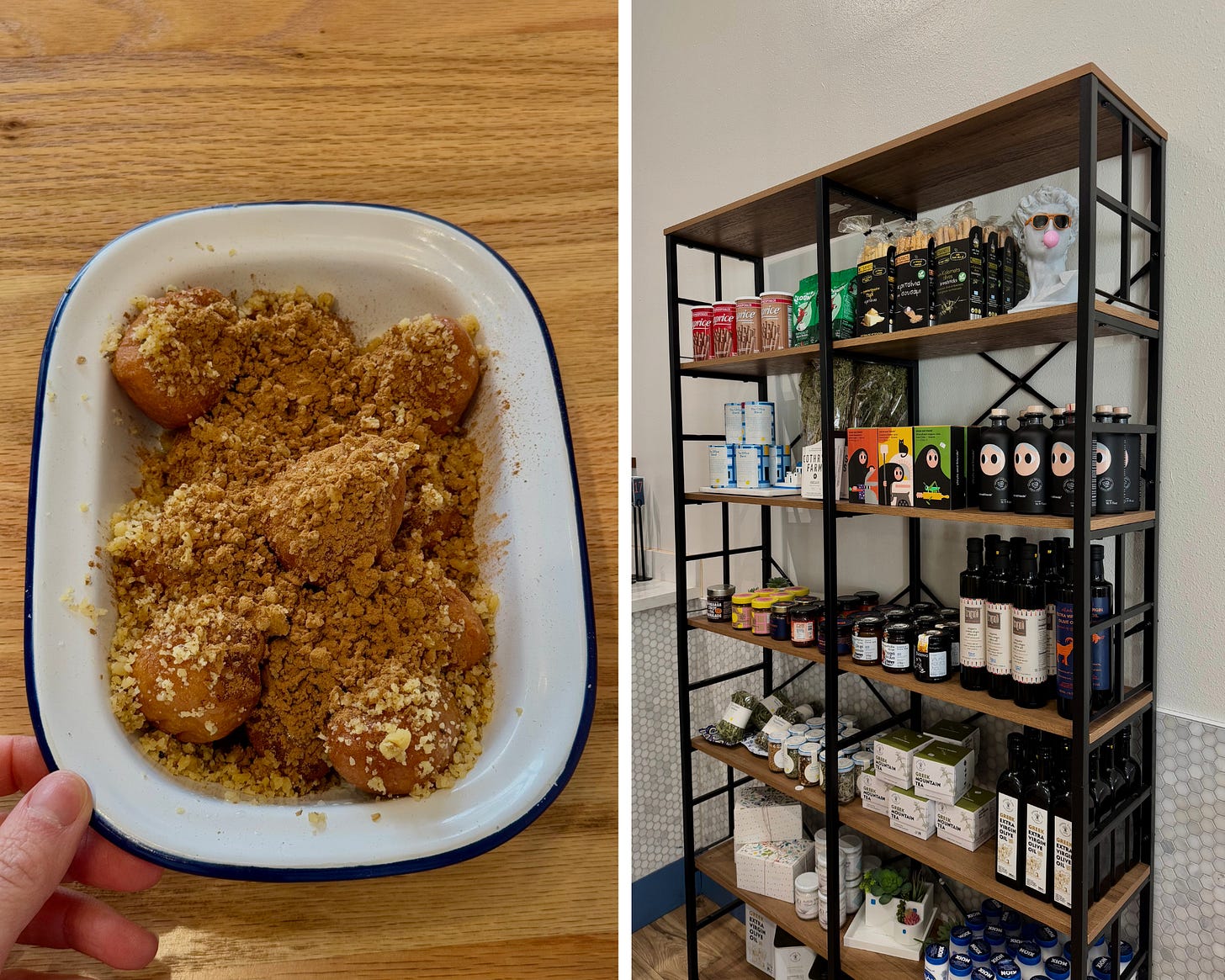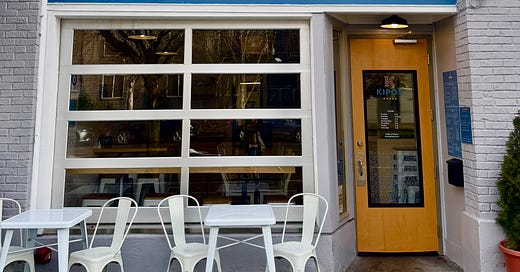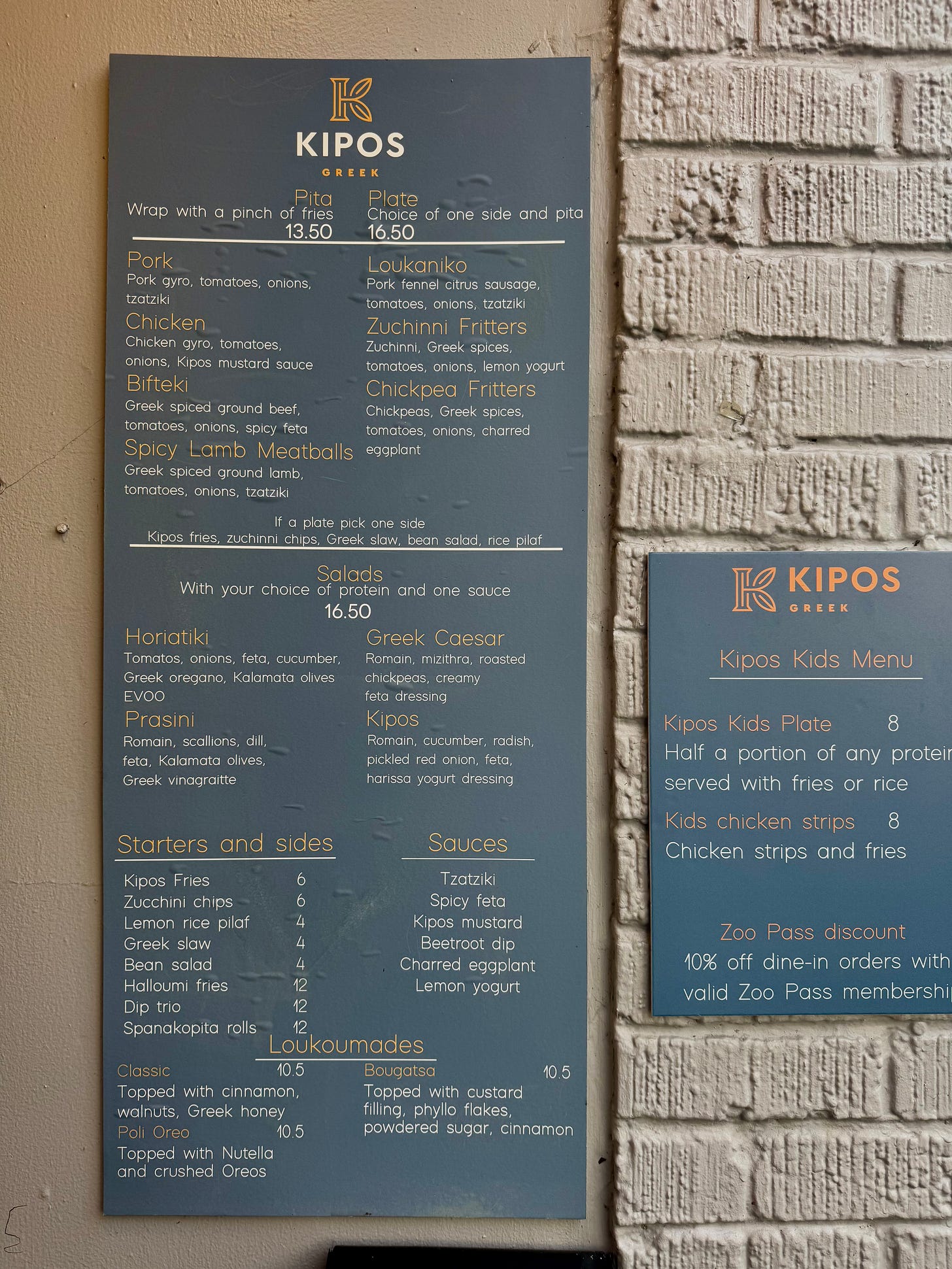Where to Eat in Seattle For "A New Understanding of Greek Street Food"
An interview with Constantinos “Dino” Bekris of Kipos Greek in Phinney Ridge
Kipos Greek opened in 2024 as a fast-casual restaurant dedicated to modern and approachable Greek street food, where “every bite is a tribute to the rich, culinary heritage of Greece.” I sat down with the owner, Constantinos “Dino” Bekris, to learn about his inspiration, what he hopes people take away from eating his food, and how the community has played a role in Kipos’ success.
LINDSEY OTTO: Can you share the story behind Kipos? What inspired you to start this restaurant?
BEKRIS: It’s a big story and a simple one at the same time. It had been something I thought about for quite some time. The main driving factor behind the concept was the dwindling of Greek food in Seattle. Growing up in Seattle, there had always been an abundance of Greek restaurants. As time has gone by, they have phased out, retired, the kids don’t want them, or the parents don’t want the kids to work in them.
Then, the [restaurants] that we do have around are sometimes not so close to what is being done in Greece. A lot of times Greeks come from Greece and they’ll eat at a Greek restaurant or have a gyro in the States and it’s unrecognizable to them. They don’t know what it is. They don’t know what the meat is, what the sauce is, it’s some variation of the tzatziki that no one is familiar with, and it’s not ill-intentioned, but it’s not accurate.
That bothered me, and that was a main motivation to do something that is representative of what and how they are eating in Greece. At the same time, revitalize — as much as one person can — the food scene in this specific area where I live.
OTTO: Tell me a bit about your background and growing up in Seattle.
BEKRIS: I don’t have a culinary background, but I grew up in restaurants, like a lot of Greek kids. My aunts had restaurants, my uncles had restaurants, my cousins' families all had restaurants. I was born in Greece but raised in Wedgwood. I lived in Ballard for seven or eight years. The last 10 years I worked for BNSF, the train company. I was driving freight trains, the ones you see going through downtown Seattle and the waterfront. It was totally unrelated.
Restaurants, it gets into a person in a way. I’m sure everyone has a friend or a lot of people themselves have thought, “Oh, it’d be cool to own a bar or a restaurant.” I don’t know what that is about the industry but it does get into you. At some point, I suppose it got into me and I returned to it. We opened in spring 2024, so we are currently still under a year old.
OTTO: How do you see your restaurant contributing to the community of Phinney Ridge?
BEKRIS: This is a great community. There is a lot of engagement from locals. They all seem to walk the neighborhood frequently, they all come in and talk to you, tell you where they’ve been and who they talked to. This place is doing this, that place is doing that.
There is a nice community feel in this neighborhood more than there is in other places. Maybe because it’s less transitory: You have less apartments, less people coming and going. The people that are here, from what I gather so far, seem to be here for the long run, so it’s in their interest to make relationships with businesses or other people in the neighborhood.
One thing that I keep getting positive feedback about is that we are open in the day time. A lot of businesses in this community are shut down during the day time, especially weekdays. It’s a little quiet at times. But we’re open and an option for people to come in for counter service. It’s not a full commitment to go sit down and do the whole thing. You can jump in and out and we do a whole lot of to-go [orders] because of that, I think. That’s positive. A lot of the zoo employees across the street are very happy that they have a quick option and can come and go.
It’s a great neighborhood. The locals are very supportive and they all seem to love what we’re doing here. We appreciate them.
OTTO: How do you see your restaurant contributing to the culture of Seattle as a whole?
BEKRIS: We have a lot of Greeks coming here from other parts of the city. They tell me, “Oh, we drove all the way from Issaquah to come eat,” or “Oh, we drove all the way from Redmond,” because the food has resonated, they appreciate the honesty of it, and it’s something that’s familiar to them.
As far as the rest of Seattle, I think we’ll get there too with them, it just takes some time for them to know we’re here. We’re a small spot, we have a small storefront, but I think over time, as the city learns that we’re here, we’ll get a lot more visitors from other neighborhoods.
OTTO: That’s really special. When people eat at Kipos, what do you hope they take away from the experience?
BEKRIS: I hope that they take away a new understanding of Greek food. In the States, the gyro is a very popular dish. It’s known everywhere, and in any city you go to in the country, you’ll find a gyro joint. What's not known is that the gyro you eat in these places is not what you’ll find in Greece.
In the 70s, Greek immigrants started this gyro cone that you see here, so it’s Greek in a way, but it’s uniquely Greek American. It’s not found in Greece. It’s kind of become the gold standard of what a gyro is — you’ll see it at Greek festivals, community events, non-Greek places, the Arabs sell it at their places, and they dominate the market locally. There is a place for it, and it’s fine and it’s good. But it’s not what you’ll find in Greece.
The main thing I like to stress on people is the pork gyro is what they do in Greece. It’s stacked up on a vertical rotisserie, it’s whole muscle meat, it’s seasoned, it’s a little labor intensive, but it’s similar to Mexican al pastor. When the Mexicans shave off the meat from the side, the Greeks do that too but it’s different spices, and it’s not in tacos, it’s in pitas. That’s my main thing. If I could accomplish one thing, it would be to reintroduce Greek food to this corner of the country.
OTTO: Is that the dish you would recommend to first time visitors?
BEKRIS: That’s where I always steer people, the pork gyro. For whatever reason, oftentimes, people are turned off by pork. They just don’t really know what to do with it. So we have other options: The bifteki and the chicken are very popular options. Those are things you will find in Greece, made that way, but we just put them in a gyro. You can pick your sauce, so that everyone can find something about it that they like.
In the States, people aren’t as rigid. In Greece, they are very rigid. They like what they like. They have the same gyro shop replicated all over the place, and they all do well. It’s not really the case here. Here people like spicy food, non-dairy food, vegan food, and a range of proteins. That's not the case in Greece, it’s kind of a monoculture — so when you bring it here, you can’t just pick it up and plop it down because it doesn’t transfer when you take it out of the cultural setting that it’s in, in my opinion. You need to make it approachable to people who don’t know. It can’t just be this super niche thing. You have to broaden it, and when you have different meat to pick from, veggie options, vegan options, sauces, now you have combinations and have broadened something without letting go of any kind of integrity or any kind of consistency with what you’re trying to do.
OTTO: Do you go back to Greece often?
BEKRIS: I do. I went a lot growing up. I was fortunate enough to be in contact and have family and friends over there. I always try to make a point to see what they are doing and see what the new thing is — I wouldn’t exactly say “trends” because there aren’t exactly trends in Greece. They have things they import from abroad that may be popular, like everyone is getting into brunch now. It sounds silly but that’s a thing now in Greece that wasn’t 5-10 years ago.
The gyro and the souvlaki in Greece just stay the same, unchanged. A lot of people now are returning to traditional gyros, which is a whole other debate: Should it have tzatziki in the pita? Should it not? Should it be gyro meat or should it be kebabs? Should it be souvlaki? So there is a bit of discussion around that in Greece but that is tinkering on the margins.
A majority of these places are the same. Every year, you go back and it’s one of the things Greeks look forward to [when] they go back to Greece. They sit down and have a gyro and enjoy themselves — have a beer, have some fries, have a salad, and chill out in the heat. That will never change for Greeks.
OTTO: So you’re really bringing a slice of that feeling to the American palate.
BEKRIS: As much as we can, yes. In America, everyone is very willing to try whatever. They don’t close doors. If you present things in a way that tastes nice and looks good, it’s good to go. Over there, it’s more rigid. Hamburgers have not gotten off the ground in Greece. Hot dogs have not gotten off the ground in Greece. There are very few McDonald’s. Very few Dominos. All those chains. [Greeks] are very set in their ways.
It’s become a point of pride for Greeks. They are very critical of even beverages coming in. Is it Greek? No? Ah, whatever. Here in the States, everyone is willing to try things. I think Kipos has something to offer people with a wide array of palates. I think people appreciate the honesty in the food and the product that we make. It’s not processed, it’s made in-house, we don’t cut corners. It’s also in a price range that’s appropriate for the casual diner, so you can go eat something, get your fill, feel good afterwards, and not break the bank while you’re doing it.
OTTO: You grew up in restaurants. Does your family currently own a restaurant as well?
BEKRIS: They’ve sold most of them and retired, but my father still owns a restaurant in the U district called Costas. It’s been there since the 70s. Everyone else has sold. They’ve come and gone. Fremont, Wallingford, Downtown, and all those places. That’s the last one standing.
OTTO: What has it meant to your family that you opened this restaurant?
BEKRIS: They’re happy for me. It’s a totally different thing that we’re doing here than what they are doing there. It’s fun to get back into business and have that mutual lifestyle to be able to talk about those things. It's nice to have someone in your family who is doing something they enjoy and you're happy for them and people come by and are supportive. That’s the best thing you can really hope for.
OTTO: Are your menu items from family recipes?
BEKRIS: No, not at all. This is Greek street food. This is not something you will eat in someone’s house, ever. Souvlaki, maybe, because that's more casual and you can buy those uncooked by the dozen. But you will never be invited into someone’s home in Greece and be served gyros, unless they go out to get them and bring them back.
These recipes are things that, over repeated trips to Greece, I’ve had to collect. A lot of people are very protective of their intellectual property. Greece is also not online the way that the States are. Here [in the States] you can type “eggs benedict” and get every recipe that’s ever existed and a lot of them could even be good enough to sell. In Greece, you type in “gyro” and nothing comes up. There’s not going to be any content. It’s all locked up [in their heads].
So I was able to get a piece here, an ingredient there, talk to this guy, and he’ll tell you something. But I had to stumble around quite a bit until I got something that I was comfortable standing up. For the gyro, that was the hardest one.
Bifteki is something you’ll find in Greek street food and the Horiatiki and Prasini are traditional salads. The zucchini fritters is [actually] my mom’s recipe. The spicy lamb meatballs are my own creation, because there is this stereotype that Greeks eat a lot of lamb, that lamb is synonymous with Greece. But really, it’s just on holidays — it’s a traditional meat, not something they eat everyday. Number one is pork in Greece, by far. I didn’t really want to have roast lamb because it dries out and it’s got its own set of difficulties, so the spicy lamb meatballs are my way of making a lamb option more appealing to an American audience.
OTTO: How long did it take you to collect these recipes in Greece?
BEKRIS: At least four or five years. A piece here, a piece there, try this, that was bad, this was dry, this was moist. It takes time, but now I have something that we’re selling that I am confident to stand behind and it’s resonating with Greek people, which means it’s passed the test. It’s begun to resonate more with our day-to-day [customers]. The pork gyros we sell, which is what I encourage all folks to get, is the thing that I’m most proud of.
It’s catching on too, I see people ordering more pork, more pork. People aren’t just hiding behind chicken all the time.

OTTO: Tell me about your desserts.
BEKRIS: Loukoumades are fried dough balls. They are a traditional street food dessert. You won’t find those everywhere, people don’t make them at their houses. Sometimes around the holidays they might. We have four different ways to top them. The classic is the traditional way: crushed walnuts, cinnamon, and Greek honey. The others [Poli Oreo, topped with Nutella and crumbled Oreos, and Bougatsa, topped with bougatsa custard, cinnamon, powdered sugar, and fried phyllo flakes] are just fun ways, which have seen a big resurgence in Greece. When I was young, you couldn’t really find them but now they’re are shops popping up everywhere that just sell those. They stuff and top them. There are hundreds of options, kind of like Baskin Robbins for loukoumades, and they look like ice cream parlors. They are really cute, speciality shops.
We don’t have baklava the way a lot of places do. In the spring though, we may launch a Greek frozen yogurt and have baklava crumbles as one of the toppings. We have a couple of other things in the works, but I want to keep it small and good.
OTTO: What are the ways this community can continue to support you?
BEKRIS: I don’t have any requests to make of anyone. The best that I can hope for is for everyone to give it a shot and they’ve done that. We had people popping their heads in all the time when we were remodeling and asking, “When are you opening? We’d love to come check it out.” As far as any business goes when you’re starting out, come give it a shot, see what it is, get something to eat. You don’t have to go every day, but as far as support, that’s all it comes down to. If you don’t like it, great. If you do like it, great, share it with a friend — which people in this community have done. It’s been as great as it can be, and we appreciate them for it.
Note: This interview has been edited for length and clarity.
Thank you for being here. If you enjoyed this interview, please consider giving it a ♥️ or share with someone you love. Your support helps sustain my work.








